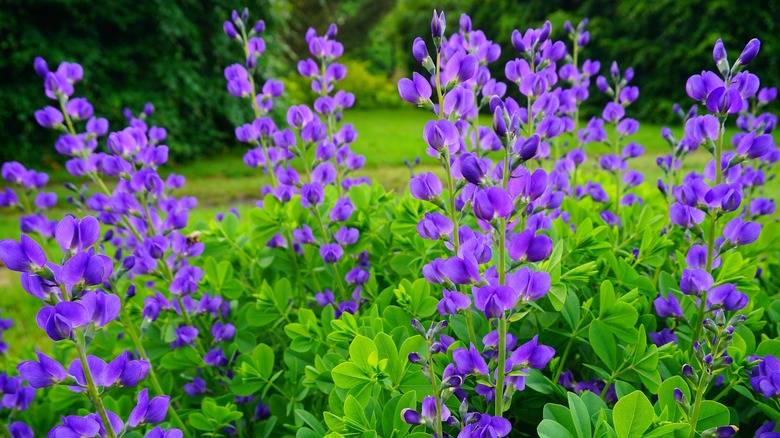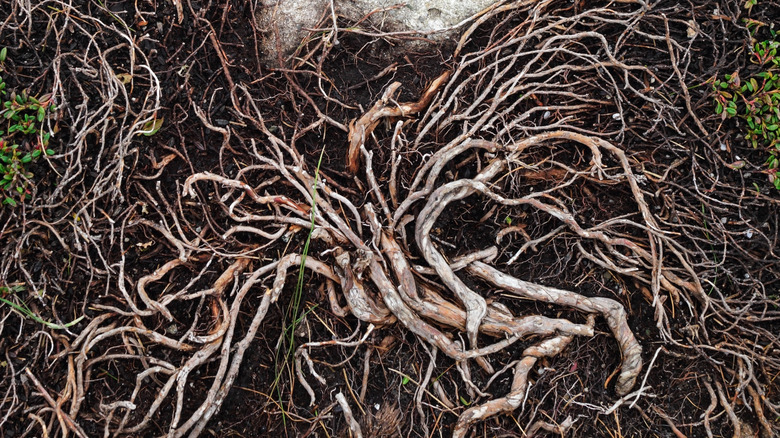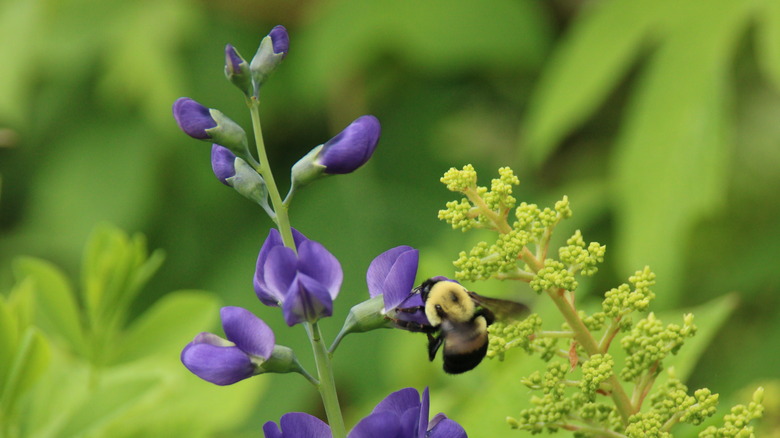Your Baptisia Plant Has A Big Problem Under The Soil (But There's A Silver Lining)
While there are many beautiful plants to choose from when landscaping, there are some that you should never grow because they're invasive. These are plants that aren't native to the environment and thatspread quickly and forcefully, often to the detriment of other native plants in the area. However, this isn't a cause for concern with the non-invasive baptisia plant (Baptisia australis) that's native to much of the United States. At the same time, however, this plant does come with one major downfall: it has a strong root system, which makes it hard to relocate and comes with other potential concerns.
It's important to remember that plants are like an iceberg. The visible part you see is only one piece of it. Beneath the earth's surface, it has a complex root system working to keep it alive and thriving. When looking at a baptisia (sometimes called false/wild indigo) in the store or the wild, you will see a resilient native perennial with beautiful purple blooms. They are known for being low maintenance and drought-resistant and will bloom for decades. However, if you are a renter or someone who likes to frequently switch up their garden design, you might want to think twice before choosing to add baptisia to your yard. It's important to know that the roots of a baptisia plant are really dense. This isn't necessarily always a negative trait, but there are some important things to consider before you plant this perennial.
Why can a deep, dense root system be a problem?
While this kind of root system isn't inherently bad, it becomes a massive problem if you need to remove or relocate the plant. Baptisia roots can extend down to 7 feet once fully mature, but it isn't just the depth that can cause gardeners a headache. The already strong roots grow to be very dense and eventually form a large, tight ball in the ground that can be borderline impossible to dig up. Trying to shovel it out will be like trying to dig in set cement. You will have to break out a saw if you want to uproot the plant, which can be done using a no-dig method with a reciprocating saw, but even then it will be hard work.
You also want to be cautious about where you choose to plant and consider the location of any water or sewage pipes. While thick tree roots and invasive plants pose the most risk to this underground infrastructure, because baptisia roots can grow so deep into the ground, it's best to avoid planting them directly above any pipes as well, just to be safe. However, this plant has not been known to harm other nearby plants. Also keep in mind that the baptisia could potentially be toxic, so keep kids and pets away.
There are some benefits to a baptisia's strong roots
While it comes with its own set of difficulties, this type of strong root system is precisely why the baptisia is such a resilient plant. They can access moisture and nutrients stored far down in the soil during dry periods, allowing them to survive extended periods of drought without wilting or suffering significant damage. This contributes to their easy-to-care-for nature.
The deep roots of this plant can also help keep your garden and home safe by preventing soil erosion. Rain, wind, and human activity can cause soil to be disrupted and eventually erode away. By adding in a strong-rooted plant like the baptisia, you can help protect slopes and gardens from damage and avoid an expensive clean-up bill by anchoring the soil and holding the hillside landscape in place. Baptisia is strong and the care is easy, making this the perfect plant for beginner gardeners. If you're willing to navigate some unruly roots, you can later sit back and enjoy the blooms in spring or early summer.


